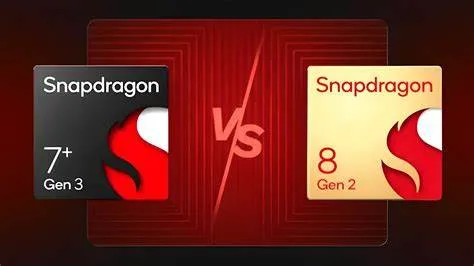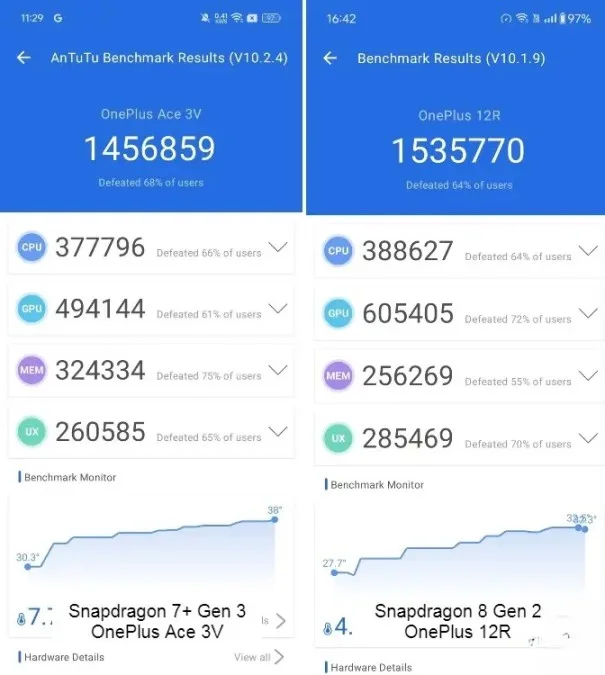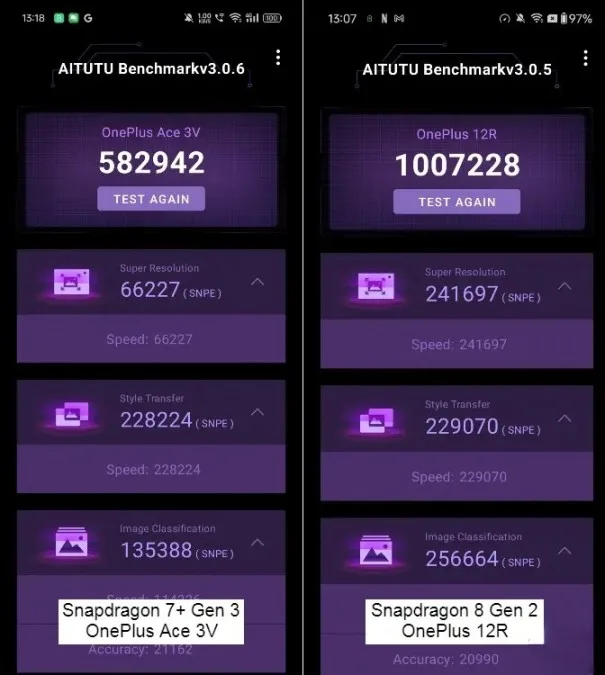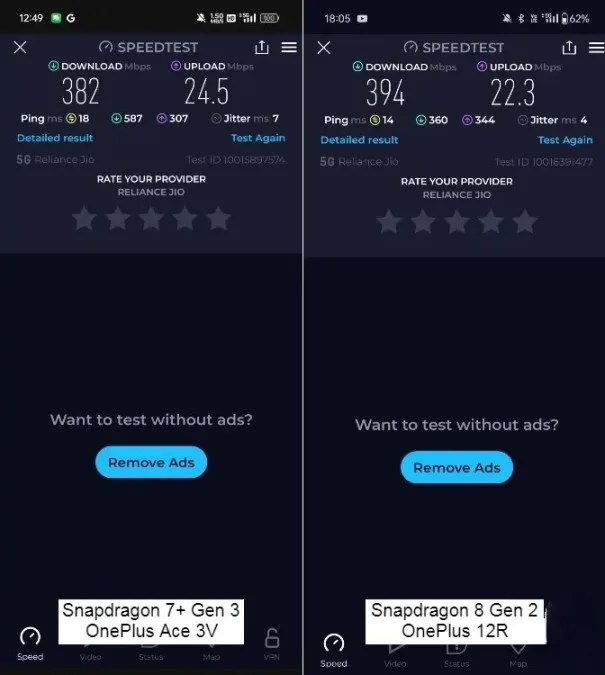
Qualcomm recently unveiled the Snapdragon 7+ Gen 3, and OnePlus has swiftly followed up with the announcement of the OnePlus Ace 3V in China, powered by this new chipset. We’ve had the opportunity to test the OnePlus Ace 3V, expected to be rebranded as the OnePlus Nord 4 in India, extensively to assess its performance. In this article, we compare the Snapdragon 7+ Gen 3 with the Snapdragon 8 Gen 2, a flagship chipset from 2022, based on our benchmark tests.
Specs Comparison
Before jumping in, first of all let’s explore the Snapdragon chipset naming convention and compare the specifications of the Snapdragon 7+ Gen 3 and Snapdragon 8 Gen 2.

Geekbench 6 Score
Our testing began with the Geekbench 6 benchmark on both chipsets to evaluate their CPU performance. In the single-core test Snapdragon 7+Gen 3 scored 1,747, while in the multi-core test it scored 4,511. In contrast, the Snapdragon 8 Gen 2 achieved slightly higher scores of 1,934 in single-core tasks and 5,367 in multi-core tasks.
Despite the Snapdragon 8 Gen 2 utilizing older cores, its high CPU frequency of up to 3.2GHz enables it to extract more performance from the chipset. On the other hand, the Snapdragon 7+ Gen 3, clocked up to 2.8GHz, delivers commendable performance while maintaining efficiency. The prospect of a 7-series chipset approaching the performance of an 8-series flagship SoC is indeed intriguing.


AnTuTu Benchmark Score
In the AnTuTu benchmark, the Snapdragon 7+ Gen 3 closely trailed the Snapdragon 8 Gen 2, scoring 14,56,859 and 15,35,770 points, respectively. This reflects a mere 5% difference in overall performance, with the SD 7+ Gen 3 almost matching the 8 Gen 2 in CPU performance.
While the Adreno 740 GPU on the Snapdragon 8 Gen 2 shows a slight advantage in the GPU test, the Adreno 732 GPU on the Snapdragon 7+ Gen 3 remains competitive. The Snapdragon 7+ Gen 3 also excels in the memory test, thanks to its pairing with UFS 4.0 storage.
The OnePlus 12R, used in this test, features older UFS 3.1 storage, which could be impacting its performance. Both chipsets, however, come equipped with LPDDR5X memory. In the UX test, both perform similarly.


CPU Throttling Test
The Snapdragon 7+ Gen 3 demonstrated impressive performance, in the CPU Throttling test. With its newer, highly efficient CPU cores, the SD 7+ Gen 3 throttled to only 84% of its maximum performance, exhibiting minimal degradation over a 15-minute test. This result remained consistent across multiple test runs.
In comparison, the Snapdragon 8 Gen 2 throttled to 75% of its maximum performance, albeit executing more instructions during the 15-minute test. Towards the end, the CPU exhibited some performance drops. Overall, the Snapdragon 7+ Gen 3 outperformed the flagship Snapdragon 8 Gen 2 SoC in terms of efficiency and sustaining high CPU stress,

3DMark Wild Life Extreme Stress Test
In our evaluation of GPU performance, we conducted the demanding 3DMark Wild Life Extreme stress test. The Adreno 732 GPU on the Snapdragon 7+ Gen 3 achieved a peak loop score of 2,954 with a minimum loop score of 2,476, maintaining a stability of 83.8%.
In comparison, the Snapdragon 8 Gen 2’s Adreno 740 GPU delivered a top loop score of 3,738 and a lowest loop score of 2,468, with a stability of 65.9%. The Adreno 740 GPU exhibits superior power, likely due to its higher clock speeds. Additionally, it features HW-accelerated Ray Tracing capability, a feature absent in the Adreno 732 GPU.

Although the Snapdragon 7+ Gen 3 doesn’t surpass the flagship Adreno 740 GPU on the Snapdragon 8 Gen 2, it boasts a capable GPU that competes well against other flagship GPUs. It’s worth noting that we didn’t conduct the Solar Bay test because the Snapdragon 7+ Gen 3 does not support Ray Tracing.

AI Performance Test
The Snapdragon 7+ Gen 3 scored 5,82,942 points, while the Snapdragon 8 Gen 2 scored nearly double, with 10,07,228 points in the AI performance test using the AITuTu benchmark. This indicates that the Hexagon NPU on the Snapdragon 8 Gen 2 is almost twice as powerful as the one on the Snapdragon 7+ Gen 3.
Additionally, we attempted to run the Geekbench ML app on the OnePlus Ace 3V but encountered repeated crashes. Once we resolve this issue, we’ll provide more AI benchmark numbers for both chipsets.


5G Speed Test
In the 5G speed test, the Snapdragon 8 Gen 2, equipped with the upgraded Snapdragon X70 5G modem, performed slightly better, achieving a peak download speed of 394 Mbps and a peak upload speed of 22.3 Mbps.
In comparison, the Snapdragon 7+ Gen 3, featuring the older Snapdragon X63 5G modem, achieved a download speed of 382 Mbps and an upload speed of 24.5 Mbps. Both tests were conducted on Jio’s 5G network.
It’s worth noting that the OnePlus Ace 3V, imported from China, may not support all 5G bands used in India, which could affect its performance on certain networks.


The Verdict
In summary, the Snapdragon 7+ Gen 3 falls short of surpassing the Snapdragon 8 Gen 2 in any benchmark tests. Nevertheless, it signifies a significant advancement, showcasing that a 7-series chipset can now rival a previous-generation flagship SoC. This positions the Snapdragon 7+ Gen 3 as an enticing chipset within the mid-range segment. We look forward to comparing it with the newly launched Qualcomm Snapdragon 8s Gen 3 once we have access to the chipset.
Are you excited about smartphones powered by the Snapdragon 7+ Gen 3? Share your thoughts in the comments below.

0 Comments